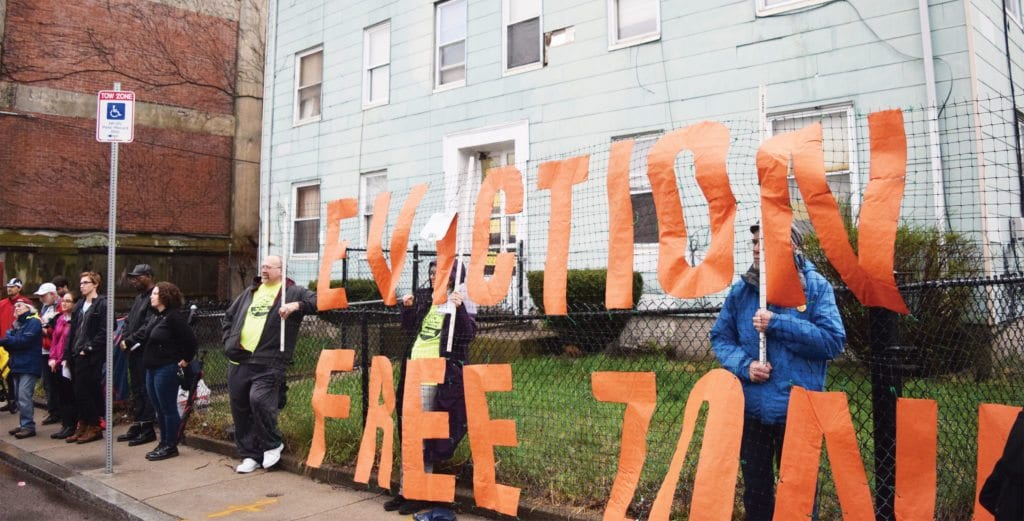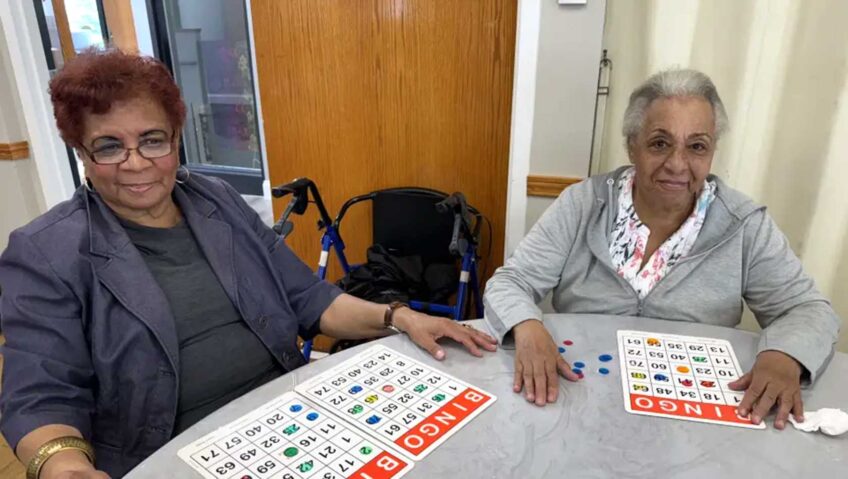Dorchester tenants challenge eviction case
New property investor snaps up affordable multi-unit home

Over 20 tenants at 6 Humphreys Place in Dorchester received eviction notices from a new property investor that recently purchased the building, but the residents are teaming up with tenants’ rights organizations to fight for their right to stay.
In February, the building’s previous landlord, Gabriel Lepe, notified the tenants that he had an interested buyer who wanted the building vacated. The residents sought help from City Life/Vida Urbana, an anti-displacement nonprofit in Boston, and Dudley Street Neighborhood Initiative, a nonprofit community land trust, to negotiate with the landlord to buy the building for the community and keep its affordability and tenants intact.

Tenant Homar Wilson speaks to the protest crowd outside 6 Humphreys Place.
However, Lepe did not respond to DSNI’s attempts at communication.
According to Ben Baldwin, operations manager for DSNI, Lepe sold the 24-unit building to Gregory McCarthy for approximately $850,000. DSNI is still trying to negotiate with the new owner.
Meanwhile, the tenants are rallying support for the passage of the Jim Brooks Stabilization Act at the State House, which was expected to be up for a vote on Wednesday, May 2.
The bill, filed by state Rep. Chynah Tyler, is intended to protect city of Boston residential tenants and former homeowners living in their homes post-foreclosure against arbitrary or unreasonable evictions.
Tenants’ rights
If passed, state law would require that a landlord or foreclosing owner who serves a tenant or former homeowner any notice to quit has to provide the tenant or former homeowner with a notice of their basic housing rights and resources, including a list of tenants’ rights organizations.
The Boston City Council voted to pass the act last October.
“The Jim Brooks Act is a really basic and crucial piece of legislation,” said Helen Matthews, communications coordinator for City Life. “This building [at 6 Humphreys Place] is a great example of tenants who learned their rights and are exercising those rights.”
Matthews said that City Life employs a three-tiered approach when working with residents in cases of displacement: the sword, the shield and the offer.
“The sword is using public pressure on landlords through rallies, vigils, petitions; the shield is legal defense from an attorney; and the offer is when we try to negotiate and take back control of the property for the community,” said Matthews.
The tenants at 6 Humphreys Place are represented by attorneys from the Harvard Legal Aid Bureau, who have worked with the residents in previous eviction attempts by Lepe. Boston’s housing court did not accept Lepe’s requests because he did not file the request in the correct court the first time, and did not use the residents’ correct names when filing in the second attempt.
The eviction notice from McCarthy is the third time the building’s residents have been told to vacate the premises.
Tunde Kunnu lives in a one-room unit in the building and is actively working with the tenants’ rights organizations to stay in his home.
“It’s affordable, it’s peaceful, we have good neighbors,” he said. “Fighting for a just cause, it empowers you and strengthens you to help other people.”
Matthews said that City Life has defended tenants in nearly 70 building clearouts over the last five years.
“And those are just the folks we know about,” she said. “Some people just pack up and leave. They don’t know their rights.”
Baldwin said that even if the Jim Brooks Act passes, it could still be improved for even further tenant protections.
“The Jim Brooks Act could be fortified with the opportunity for tenants to purchase,” he said. “They could get an offer and then the tenants have the opportunity to get someone like DSNI to make a [counter] offer without evicting all of the tenants.”






